Home
KASHBA Asiatica
Ais Loupatty
Ton Lankreijer
Staalstraat 6
1011 JL Amsterdam
Open 12:00 – 17:00
Zondag / Sunday 14:00 - 17:00
Contact:
31-20 - 6 23 55 64
06 - 588 41 370

Tekst invoeren
Even the concept of God implies plurality: true or false.
Just joking.
Wikikids explains it in a more entertaining way:
Gods came into existence because people in the past didn’t know what things were. For example, people didn’t know what lightning was. So they invented gods. They had a god or goddess for everything.
Initially, our distant ancestors compared the forces of nature to animals, such as the fury of a bull or the swollen udders of a cow.
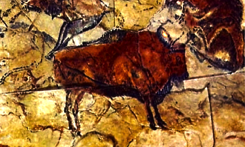
Later, they began to personify such forces as humans.
For example as a muscular man or a busty woman.

Lightning bolts were given names and human shapes, such as those of Thor or Indra.
The wrathful faces they were given show how frightening the heavenly fire was considered to be.
This was also evident from the weapon they held aloft.
How could Thor's thunder be better depicted than with a grotesque hammer?
Indra was provided with a sceptre with rays shooting out in all directions, enabling him to flash beams of light between the heavy clouds of the monsoon season.


If the image was too sketchy or clumsy, these objects still made it clear what specific power was meant and what it could cause.
Writing a name or explanation was not an option: only very, very few people could read. The art of writing and reading only gradually developed worldwide in the last century.

Those who wanted to indicate more aspects or qualities of a specific strength did so through body language.
For example, with a fist or an open hand.
Or through a combative posture or a peaceful lotus position.
The possibilities are endless and recognition is immediate.
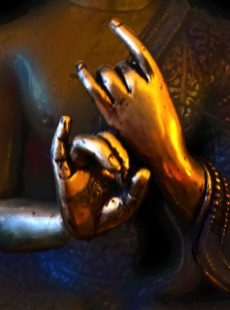
Over time, a simple sketch of the object was often enough to identify it – they turned into symbols.
- An arrow (without a bow) pointed to something else, something that couldn't be depicted. It wasn't visible, but people suspected it was there.
- A circle could represent the enormous ball of light in the sky that gave life to everything, but which was too powerful to look at directly.
- A lotus flower refers to emerging from the mud, rising through the dark water to the surface, only to blossom in the light.

To prevent a meditating man from merely staring inward, a female figure sometimes embraces him, holding the symbols of a skull and a skull knife in her hands.
The two merge into one and are therefore – very vividly – also physically intertwined; yab-yum (or father-mother).
And for further explanation sometimes even a few more rows.

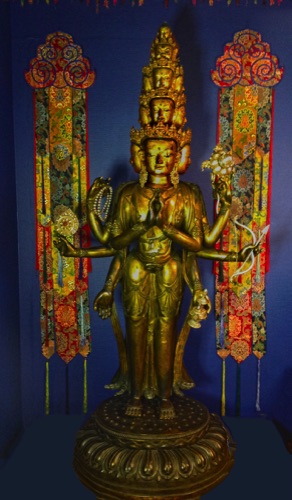
- Daily dedication was required, like beads on a prayer string.
- But all of this held promise, which could only blossom thanks to the sacred water of love and compassion.
- Only then did insight strike - like a bolt of lightning - that it was like a diamond in your hands to be applied in actuality.
Anyone who wants to capture something like this in a single figure will soon find themselves needing six arms.

Labelling all these forces gods, demigods or idols creates confusion.
A few billion people speak of our God and their gods.
The former as the only true one, the rest as false.
What is remarkable, however, is that the other few billion people do not refer to 'gods' at all.
For millennia, they are not worshippers of gods but have developed entirely different concepts such as deva, yogini, or bodhisattva to understand the world and their place in it.
But this diversity is not apparent to the devout believer in God. Over time, the other couple of billion people, particularly English speakers, began to speak of ‘our gods’ to outsiders as an explanation of their religious projections.

Oh well, as long as the well-intentioned message comes across.
Otherwise, gods and symbols refer to nothing.
Or, alas, to the opposite.
Ultimately, the root of the word 'significance' traces back to 'signum', meaning sign or mark.
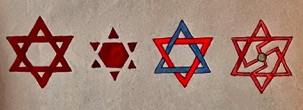
Take the swastika symbol, a sign that has been given very different meanings in at least three cultures over the past millennia.
- In China, it was once used to represent a constellation in the sky.
- In India, it was seen as a creative centrifugal force, akin to the motion of a garden sprinkler.

Een rabbi staat voor zijn gemeente, heft zijn armen en proclameert: ‘Ik ben rabbi, een goede rabbi, maar ik sta hier als niets voor u, God, als nìets.’
De voorganger doet daarop een stap naar voren en zegt met luide stem: ‘Ik ben voorzanger, een goede voorzanger, maar ik sta hier als niets voor u, God, als nìets.’
Vervolgens komt er 'n kleermaker naar voren en zegt: ‘Ik ben kleermaker, een goede kleermaker, maar ik sta hier als niets voor u, God, als nìets.’
De rabbi kijkt de voorganger aan en zegt: ‘Wie denkt hij wel dat hij is... dat hij denkt dat hij niets is..!?’
- Martin Buber
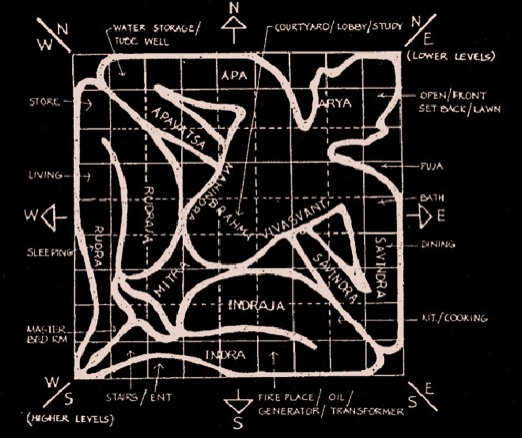
- In Europe (including Russia), the symbol was considered a bringer of good luck, in line with the etymological translation of suvastika (Sanskrit): sign of well-being.
- Nazi Germany seized upon this and built a whole mythology around it—but that is recent and well known.

Or place two triangles opposite each other to form a six-pointed star. This symbol has been used around the world for thousands of years and remains prevalent in many cultures today. However, its meaning varies greatly.
On the Indian subcontinent, the upward triangle was seen as a man and the downward triangle as a woman. An abstract yab-yum version, so to speak.
Kortom, symbolentaal (pasigrafie) kon nooit een wereldtaal worden, zelfs geen grafisch Esperanto. De betekenis is daarvoor te zeer afhankelijk van plaats en tijdsgewricht.
Dat lijkt beter te lukken met pictogrammen als ‘visuele ondersteuning’ dankzij computersystemen, vlieghavens, enzovoort. Maar voor hoe lang?
Het icoontje voor een telefoon is vooroorlogs. Wie weet nog wat welke emoticon precies betekent ? 😊
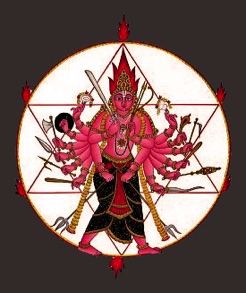
Overigens, ook geschreven woorden zijn symbolen die verwijzen. Eenmaal begrepen, vervliegen ze weer.
De Indiase wijsgeer Nisargadatta verwoordt het mooi en compact:
‘Words are used to point beyond words. When the message is understood, the words fall away.’
Tja, was dat maar waar.
‘Van jouw mond in God’s oren,’ zeiden ze vroeger wel.
Maar al te vaak worden de woorden verankerd in onwrikbaar heilige boeken die uiteraard alleen priesters en predikanten naar waarheid kunnen begrijpen.
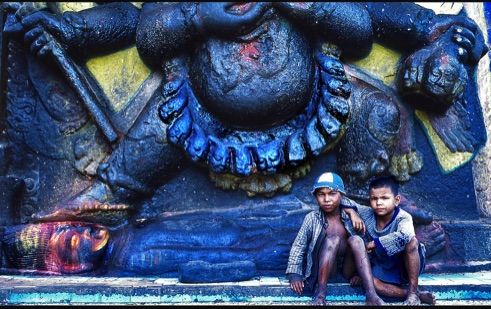
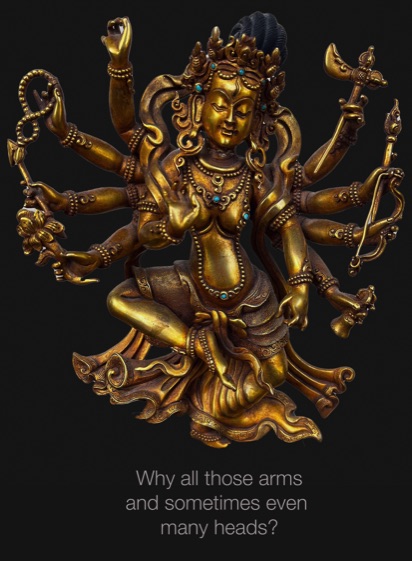
The choice of two figures then becomes appealing. It allows to highlight different aspects. Not as opposites, but as complements to each other.
Next to a man holding aloft the sword of knowledge (with which he cuts through knots), an embracing female figure may indicate the compassion needed to reach a wise decision.

